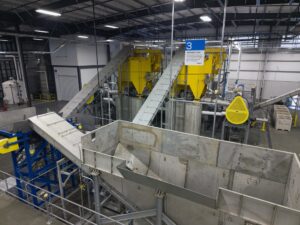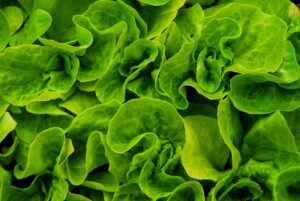September 3, 2024
In this blog: What is Anaerobic Digestion? | Anaerobic Digestion vs Composting | Managing Wasted Food on a Commercial Scale | Divert’s Approach to Sustainable Food Waste Management
Summary: As businesses along the food value chain look for ways to reduce their environmental footprint, innovations are being made in sustainable food waste management. In this post, we explore anaerobic digestion and how it’s being scaled to recycle wasted food into energy.
Food waste—63 million tons of it per year in the U.S.—takes up one-third of space in America’s landfills, and that capacity is shrinking every day. The food industry contributes roughly 52% of all food waste that ends up in landfills, costing those businesses an estimated $218 billion annually to facilitate the disposal of all the unsold food.
The sheer scale and costs associated with wasted food have created a nexus of environmental and social crises:
- Greenhouse gas emissions: Left to rot in landfills, food waste produces harmful greenhouse gas emissions such as methane, which has about 80 times the warming power of carbon dioxide over the first 20 years. It’s estimated that only about 50% of this gas is captured with landfill gas systems, while the rest escapes into the atmosphere. Wasted food contributes 8-10% of global greenhouse gas emissions.
- Water loss: Food waste is 85% water. In a landfill, all of that water becomes toxic leachate by picking up contaminates as it percolates through the trash. If we recycle food rather than throwing it away, we can recover the water content, treat it, and return it to our waterways for future use.
- Nutrient loss: Similar to the loss of valuable water, the nutrients contained within food are also wasted and forever contaminated once they reach the landfill, when they could be recycled and put back into the land as soil amendment.
- Food insecurity: Meanwhile, an estimated 44 million people are food insecure in America. Much of the food sent to landfills is actually edible, representing a lost opportunity to address the hunger crisis.
Given the growing environmental, social, and economic risks associated with wasted food, governments are taking action to drive change in how businesses manage their unsold and uneaten food. These new guidelines and regulations not only emphasize source reduction and feeding the hungry, but making use of wasted food as a resource through processes like anaerobic digestion.
In this post, we’re taking a deep dive into anaerobic digestion (AD) and how it is being scaled to help food businesses across the U.S. implement sustainable food waste management.
What is Anaerobic Digestion?
Anaerobic digestion, which occurs naturally through marshes and swamps, is a type of anaerobic decomposition – a process through which bacteria break down organic matter in the absence of oxygen.
Using Divert’s proprietary process as an example, here’s how anaerobic digestion works:
- Food waste arrives at our anaerobic digestion sites and the contents are depackaged, producing a liquid slurry rich in organic material.
- The slurry is filtered for microplastics and pumped into the digester tank, which is seeded with bacteria that will naturally break down the organic material.
- The organic material from the slurry is digested and separated into biogas and extra solids.
- The solids are separated and refined into soil amendment, while the biogas is used for energy production.
Anaerobic digestion produces two beneficial byproducts:
- Biogas that can be converted to renewable natural gas to reduce reliance on fossil fuels
- Digestate that can be used as an amendment to enrich agricultural soil, similar to compost
Through anaerobic digestion, nearly 100% of wasted food’s organic matter is put to beneficial use: about 90% of the organic matter from wasted food can be recovered as biogas to produce energy, while the remaining 10% is processed into solid soil amendment. The water can be sent through standard wastewater treatment processing and returned to the environment, or it can be repurposed for irrigation.
A notable environmental benefit of AD is a net reduction of greenhouse gas emissions. From the diversion effort alone—before any renewable energy is produced—a net reduction in greenhouse gas (GHG) emissions is achieved. This is possible because the food’s embedded energy is captured instead of being released into the environment as methane and CO2 during landfill decomposition. From this baseline, converting the resulting biogas into energy has the added benefit of reducing GHG emissions further by eliminating the emissions that would otherwise be generated by the production and usage of fossil fuels for energy.
Anaerobic Digestion vs. Composting: What’s the Difference?
Anaerobic digestion and composting are both methods for processing organic waste and converting it into beneficial byproducts. Both composting and AD have environmental benefits: they both reduce the volume of waste sent to landfills, decrease greenhouse gas emissions, and recycle nutrients back into the environment.
Although there are similarities between the two, there are some key differences between anaerobic digestion and composting:
- Their use of oxygen: Whereas anaerobic digestion is the decomposition of organic matter in the absence of oxygen, composting is aerobic, meaning it requires oxygen to decompose organic matter.
- Acceptable materials: Anaerobic digestion and composting accept different materials. While composting can accept fibrous materials such as wood, AD accepts things like dairy products and deli meat, and many processed and frozen foods.
- Byproducts: As mentioned above, AD produces biogas and digestate, an agricultural soil amendment similar to compost.
- Energy: AD produces biogas, which can be converted into renewable natural gas or electricity, whereas composting does not generate energy.
- Processing conditions:
- Byproduct quality: To achieve the right balance of nutrients and the right consistency, compost requires semi-enclosed systems with exposure to oxygen, while AD takes place in a sealed, controlled environment called a digester. Because organic food waste is 80 – 85% water, compost requires other inputs such as dry yard waste (leaves, grass clippings, etc) to assure proper oxygen availability in the pile – unlike anaerobic decomposition, which occurs in oxygen-free environments and can process high-moisture materials without dilution.
- Filtering out microplastics: Another key difference is how commercial facilities for AD and composting are able to manage microplastics. While composting is an ideal solution for clean food waste, most commercial food products (nearly anything post-farm) comes in contact with and transfers microplastics (think: produce stickers and plastic wrappers.) Current composting processes and technology typically leave behind some microplastics, while anaerobic digestion processes can filter these out more effectively.
- Location, e.g., urban vs. rural areas: In rural farm areas, composting can be an ideal circular solution for reapplying organic matter back to agricultural soil. For commercial businesses in urban areas where there is no agricultural land to accept the organic material, and there is high population density, transportation of the organic material becomes a challenge; the further the compost has to be transported, the more emissions it creates and the less sustainable it becomes. Anaerobic digestion significantly reduces the organic mass, making it more sustainable to transport, and biogas can be piped into local energy systems.
Anaerobic digestion and composting can be complementary processes. In some cases, anaerobic digestion and composting can be integrated as a two-step process to increase the quality of byproducts like digestate and overall efficiency of the system itself.
Changing the Way Wasted Food is Managed on a Commercial Scale
As food industry businesses prepare to comply with emerging organic waste regulations, and given the differences between composting and anaerobic digestion, careful consideration must be given to where their wasted food is sent and how it is processed, and the total environmental impact of any solution they choose.
The EPA’s new Wasted Food Scale, released in 2023, provides a helpful framework for evaluating which method is most sustainable for commercial food waste from producers, distributors, retail grocers, restaurants, and others.
The EPA Wasted Food Scale prioritizes Prevention and Feeding Others over recycling pathways: any food that is edible and able to be donated should be given to those who need it most. Yet, some amount of wasted food is inevitable, and for inedible food, sustainable pathways such as composting or anaerobic digestion are key to preventing landfill waste.
Divert’s analysis of the EPA’s Wasted Food Scale uncovered two key findings:
- Anaerobic digestion ranked higher than composting in the EPA’s Life Cycle Assessment, in terms of global warming potential, energy demand, and environmental benefits.
- Anaerobic digestion ranked higher than composting in the EPA’s Circularity Assessment in terms of waste prevention, value, purity, and regeneration.
So, while composting is a great option for processing clean food waste that is close to its source (think: unsold produce on farms that can be mixed with other organic waste like dry plant residue to balance moisture levels), anaerobic digestion technology is designed to manage the challenges of high volumes of inedible food further down the value chain because it can handle the high moisture content of organic waste, filter it for microplastics, and apply it to local energy infrastructure.
Divert’s Approach to Sustainable Food Waste Management
When wasted food can’t be prevented or donated, we have a responsibility to capture its remaining value. We take a holistic approach to wasted food diversion, working with our customers to prevent waste upstream, increase donations of edible food to local food banks, and recycle inedible food into carbon negative renewable natural gas and digestate via our anaerobic digestion process.
Through our partnerships with grocery retailers and other food industry businesses across the U.S., we’ve been able to process more than two billion pounds of wasted food to date. Our proprietary technology is able to screen the organic material down to a millimeter to remove detectable plastics, resulting in high-quality byproducts. Our reverse logistics process utilizes existing transportation workflows to make the entire process of wasted food collection and recycling efficient while minimizing additional carbon emissions.
With this approach, we’re not only helping our customers fulfill their ESG commitments, we’re creating a new, sustainable organic waste management system that can redirect inedible food to its best and highest use for generations to come.
Are you ready to make a measurable impact on your waste reduction goals? Contact us today to learn more about our solutions.



